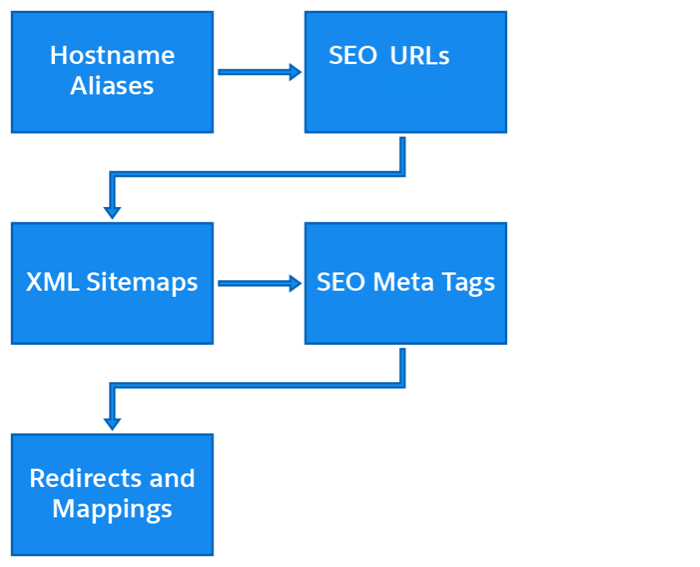Explore Search Engine Optimization
Learning Objectives
- List five Salesforce B2C Commerce SEO features.
- Explain the benefits of using hostname aliases.
- Define three common hostname alias terms.
- List three tasks you need to accomplish to implement B2C Commerce meta tags.
SEO and B2C Commerce
At Cloud Kicks, a company that specializes in high-end custom sneakers, senior merchandiser Brandon Wilson is all about increasing non-paid search engine results for his company’s storefront.

He’s eager to design and implement a fabulous search engine optimization (SEO) strategy to make this happen. When a shopper does a Google search, for example, he wants the right combination of creative and technical elements on the Cloud Kicks site to place that site at the top of the shopper’s search results list.
He has a lot to consider.
For one thing, Google gives a lower search results ranking to sites with super-long URLs and multiple directory layers and parameters. So he already knows what to avoid.
With these B2C Commerce SEO features, Brandon can make a difference.
- Hostname aliases: Configure all variants of a website’s name to lead to the website.
- SEO URLs: Shrink the URLs to a searchable and human readable size.
- XML sitemaps: Tell search engines what’s on the site.
- SEO meta tags: Describe a page’s content to improve your site SEO ranking.
- Redirects and mappings: Redirect shoppers to the right place.

The following table shows what you need to do to design, configure, deploy, and maintain these features. Note that:
- Metadata is data (info) about data on an HTML page that doesn’t display but is readable by browsers, search engines, and other web services. The <meta> tag is where you put the metadata—such as the page description and the HTML page’s author—on the HTML page.
- 301, 302, and 404 are HTTP response status codes.
| For... | Do this... |
|---|---|
| Hostnames |
|
| SEO URLs |
|
| XML Sitemaps |
|
| Redirects and Mappings |
|
| Meta Tags |
|
Brandon takes a closer look at these features to help Cloud Kicks shoppers land exactly where they are supposed to.
In this module, we follow along as he explores hostname aliases: what they are, how they help, and how to configure and use them.
Hostname Aliases
You can use B2C Commerce to create hostname aliases that get shoppers where they need to be via a storefront’s URLs. Aliases generate 301 redirects for host-only URLs and let you redirect URLs to locale- or device-specific sites. You can use them to redirect to other aliases, too.
The hostname alias file defines what hostnames/domains B2C Commerce supports. It also defines what pipelines or controllers are triggered (automatically run) for a specific URL.
Controllers are server-side scripts that process the data (and actions) entered into the storefront. They manage the flow of control in the storefront application. Pipelines predate controllers and provide similar functionality. Brandon works with Vijay Lahiri, a developer, to figure out which pipeline or controller to use. Later he'll work with Vijay on some other tasks as well.
Host-only URLs can open specific pipelines. For example, www.your.host.com can open the Home-Show pipeline. In the B2C Commerce world, it’s important to configure hostname aliases, even for the basic storefront URL.
Use this terminology when configuring hostname aliases.
| Element | Description |
|---|---|
| Entered URL |
The URL entered by the shopper. |
| Host Name |
The part of the URL that indicates the host name, for example: www.cloudkicks.com. |
| Site path |
An optional slash-delimited URL segment that’s appended to the host name. B2C Commerce uses it to differentiate between multiple sites with the same hostname. Take this hostname, for example: http://www.cloudkicks.com
|
| Locale |
An optional locale identifier you can specify in mapping rules. (We get to mapping rules in a later unit.) B2C Commerce uses a locale configured in a mapping rule if the hostname (or the hostname plus the site path) matches the beginning part of the entered URL. For each entered URL, B2C Commerce determines the correct locale from the hostname alias files. If there’s no corresponding mapping rule, it falls back to the site’s default locale. |
| Path |
The part of a URL that indicates the path to the page. The path is logically appended to the locale (if there is one), to the site path (if there is one), or to the host name. For example, /womens/accessories/promopage.html is appended to http://www.cloudkicks.com/us, to make http://www.cloudkicks.com/us/womens/accessories/promopage.html. |
Scenarios
Brandon explores ways he can use this technology.
| He wants to... | Here's an example. |
|---|---|
| Configure a single domain for multiple sites. | site 1, locale A is www.cloudkicks.com/us, site 2, locale A is www.cloudkicks.com/uk, and site 2, locale B is www.cloudkicks.com/de. |
| Implement a new site name, but keep the old domains active, even when the old sites are shut down, so Cloud Kicks can get its traffic. | www.cloudkicks.com, cloudkicks.com , or www.anothercloudkicksdomain.com. |
| Automatically handle common site name misspellings. | amerzon instead of amazon or www.cloudkicks.com and www.cloudkickss.com. |
| Associate an alias with a locale. | www.cloudkicks.de triggers the de_DE locale. |
| Associate an alias with a locale-specific landing page. | shoes.cloudkicks.com automatically navigates to the Shoes category page. |
| Associate an alias with device-specific pages. | m.cloudkicks.com for mobile devices such as smartphones. |